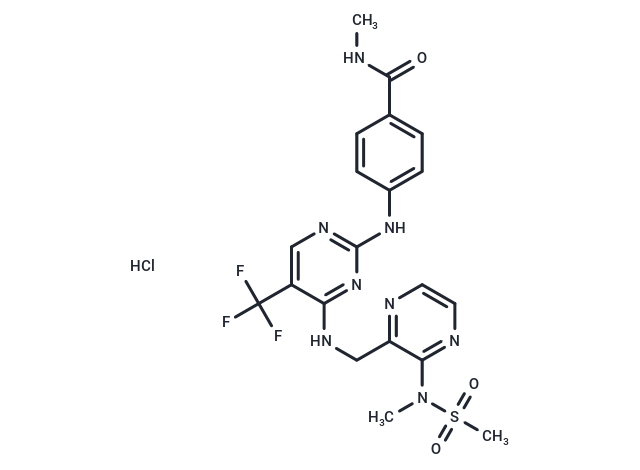Shopping Cart
Remove All Your shopping cart is currently empty
Your shopping cart is currently empty
Defactinib hydrochloride (PF 04554878 hydrochloride) is a novel inhibitor of FAK. Which inhibits FAK phosphorylation at the Tyr397 site in a time- and dose-dependent manner.

| Pack Size | Price | USA Warehouse | Global Warehouse | Quantity |
|---|---|---|---|---|
| 1 mg | $30 | In Stock | In Stock | |
| 5 mg | $64 | In Stock | In Stock | |
| 10 mg | $91 | In Stock | In Stock | |
| 25 mg | $148 | In Stock | In Stock |
| Description | Defactinib hydrochloride (PF 04554878 hydrochloride) is a novel inhibitor of FAK. Which inhibits FAK phosphorylation at the Tyr397 site in a time- and dose-dependent manner. |
| In vitro | Defactinib suppresses pFAK (protein Focal Adhesion Kinase) expression within three hours, exhibiting a dose-dependent inhibition, particularly at the Tyr397 phosphorylation site, and showing a reduction in expression levels by 48 hours. It effectively diminishes FAK phosphorylation over time and in correlation with the administered dose. Additionally, Reverse Phase Protein Array (RPPA) analysis reveals that Defactinib lowers AKT and YB-1 levels in taxane-resistant cell lines. The inhibition of pFAK (Tyr397) by Defactinib is confirmed to be statistically significant and dose-responsive across various cell lines, as documented in source [1]. |
| In vivo | In the HeyA8 model, PTX monotherapy achieved an 87.4% decrease in tumor weight, while combination therapy yielded a superior 97.9% reduction (P=0.05 compared with PTX). Defactinib treatment at 25 mg/kg, administered orally twice daily, significantly decreased pFAK (Tyr397) levels, with effects reversing within 24 hours, establishing this dose for further experiments. For these, female nude mice with HeyA8 tumors in the peritoneal cavity were divided into four groups (n=10 each): 1) control group receiving vehicle and phosphate-buffered saline, 2) Defactinib (25 mg/kg orally, twice daily), 3) PTX weekly, and 4) both Defactinib and PTX. The SKOV3ip1 model demonstrated a 92.7% tumor weight reduction with the combination therapy compared to PTX alone (P<0.001)[1]. |
| Synonyms | VS-6063 hydrochloride, PF 04554878 hydrochloride |
| Molecular Weight | 546.95 |
| Formula | C20H22ClF3N8O3S |
| Cas No. | 1073160-26-5 |
| Smiles | Cl.CNC(=O)c1ccc(Nc2ncc(c(NCc3nccnc3N(C)S(C)(=O)=O)n2)C(F)(F)F)cc1 |
| Relative Density. | no data available |
| Storage | keep away from direct sunlight | Powder: -20°C for 3 years | In solvent: -80°C for 1 year | Shipping with blue ice/Shipping at ambient temperature. |
| Solubility Information | DMSO: 22.5 mg/mL (41.14 mM), Sonication is recommended. H2O: 0.1 mg/mL (0.18 mM) |
| In Vivo Formulation | 10% DMSO+40% PEG300+5% Tween-80+45% Saline: 0.5 mg/mL (0.91 mM), Sonication is recommeded. Please add the solvents sequentially, clarifying the solution as much as possible before adding the next one. Dissolve by heating and/or sonication if necessary. Working solution is recommended to be prepared and used immediately. The formulation provided above is for reference purposes only. In vivo formulations may vary and should be modified based on specific experimental conditions. |
| Size | Quantity | Unit Price | Amount | Operation |
|---|

Copyright © 2015-2025 TargetMol Chemicals Inc. All Rights Reserved.